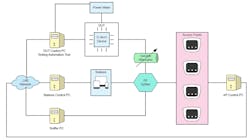Members can download this article in PDF format.
Wi-Fi has pushed the boundaries of communication speed, range, and integration as capabilities like lower power and new protocol features boost the number of wireless applications. According to the Wi-Fi Alliance, nearly 18 billion Wi-Fi devices will be in use this year, and more than 4.4 billion devices will ship in 2022. Wi-Fi is commonly used in consumer, industrial, and enterprise applications to enable wireless connections between devices and the cloud.
Wi-Fi can be found in video-surveillance, HVAC, and access-control products for smart buildings; patient monitors and medical equipment used in healthcare; smart meters and solar/renewable-energy systems employed in grid infrastructure; and many more products that need connection to the internet.
Why is your Wi-Fi connection so important and why does it matter if it’s fast and strong? Because we rely on it to remain productive and innovative. Bottom line, though, we simply need it to work no matter what.
Sponsored Resources:
- A Wi-Fi portfolio that is built to last
- Wi-Fi interoperability test lab tour
- TI Wi-Fi Test Strategy Overview
With more people and things becoming connected than ever, Texas Instruments’ (TI) goal is to provide the freedom and flexibility to connect anything. If you’re developing a product with Wi-Fi connectivity, you need a reliable and tested Wi-Fi device to ensure that your product will connect in any environment.
That means fast speeds and reliable internet connection all of the time. TI has been one of the leaders in Wi-Fi solutions for embedded devices for more than a decade. Its product range of SimpleLink Wi-Fi chips and MCUs offer a wide range of choices and options. What’s more, TI Wi-Fi devices implement robust security features without any burden on the main MCU, enabling secure cloud-connected IoT applications.
Of course, when tech companies say your data is in the cloud, they mean it’s stored somewhere (in many somewheres, actually) on the internet, instead of locally on your computer. A network of web servers will find what you’re looking for and deliver it.
SimpleLink Wi-Fi wireless microcontrollers (MCUs) are used as the main host to enable cloud connectivity. All are proven, tested, and adaptable for high-performance and/or low-power, security-enabled IoT applications.
The company’s view as to how wireless connectivity allows us to quickly adapt and stay productive is explained more fully in an article on what TI does to ensure its Wi-Fi solutions remain reliable.
Software- and Hardware-Based Security
Consumers want the best user experience with their connected devices, so that they can securely transfer data over the internet without interruption of communication. To achieve this, developers need to design IoT products with great Wi-Fi connectivity as well as implement security measures that will protect end-user’s privacy.
To protect the end-user’s assets, TI’s SimpleLink wireless MCUs integrate a host of multilayered software- and hardware-based security features. Such tools help protect your products from local packet sniffing, man-in-the-middle server emulation, hostile takeovers via over-the-air (OTA) updates, remote file manipulation, data and software theft, intellectual-property (IP) cloning, and more.
The SimpleLink Wi-Fi CC3x3x and CC3x20 devices offer effective built-in security features, without any processing burden on the main MCU, allowing for development of secure wireless and cloud-connected applications. Among the security features are secure storage, secure content delivery, secure connection to the cloud, and the use of hardware cryptographic accelerators. In addition, the devices meet some of the highest level of security with FIPS 140-2 validation (FIPS is the Federal Information Processing Standard).
Providing Reliable Performance
Some of the important factors when choosing a connectivity device is the Wi-Fi device's ability to provide reliable performance, security, and a high level of worldwide interoperability. The reliability of a system is defined as the probability that a system, including all hardware, firmware, and software, will satisfactorily perform the task for which it was designed, for a specified time, and in a specified environment.
When it’s fast and reliable, a wireless connection can help you accomplish some pretty amazing feats. In terms of reliability, TI’s Wi-Fi chipsets are engineered to be able to function without pause in adverse environments that have obstructions, such as in homes or offices, or in highly congested environments like factories and hospitals. They’re adaptable for high-performance or low-power, security-enabled IoT applications.
The chipsets are designed to work outdoors as well as at temperatures above 85°C, making them suitable for use on the grid and for supporting infrastructure. This is due to robust radios with high RF performance, advanced features such as a proprietary network learning algorithm, and more. Resiliency is ensured with a comprehensive testing strategy, including interoperability tests across hundreds of access points (see figure). That way, no matter where in the world a product goes, it just works.
TI has invested in making sure that its SimpleLink and WiLink device families (WiLink is a combo device supporting Bluetooth and Bluetooth Low Energy functionality along with IEEE 802.11 a, b, g, and n bands on a single chip) have best-in-class stability and robustness to handle real-life scenarios (see table). Stability tests validate that the device can function as designed for long periods without degradation in performance or interruptions in the service (for example, disconnections).
Built-in Simplicity
Unnecessary complexity is one of the common mechanisms that can lead to electronics failures. In Wi-Fi, provisioning is the method that connects a device to a network. To simplify matters, a SimpleLink Wi-Fi device can be turned into an access point for a brief period of time where the embedded device is hosting a web server.
The device has what’s known as a network processor inside of it. This networking subsystem includes all of the provisioning. What that means is the host—i.e., the microcontroller, whether that's on a CC3200 or 3220 with the built-in microcontroller, or a CC3100 or 3120, which is connected to an external host like any of the CC26xx devices—is going to perform all of the steps needed.
Making the Move
So, let's get this party started: The SimpleLink Wi-Fi CC3235 LaunchPad and CC3220 LaunchPad are the best way to begin with the SimpleLink Wi-Fi family. The CC32XX devices include both an applications processor and a network processor.
SimpleLink Academy is another great starting point for developers to learn about the SimpleLink MCU Platform. SimpleLink Academy delivers easy-to-use training modules that span a wide range of topics for all LaunchPads in the SimpleLink MCU family. In addition, the E2E Wireless Connectivity forum is the go-to source for help in the design process.
Sponsored Resources:


